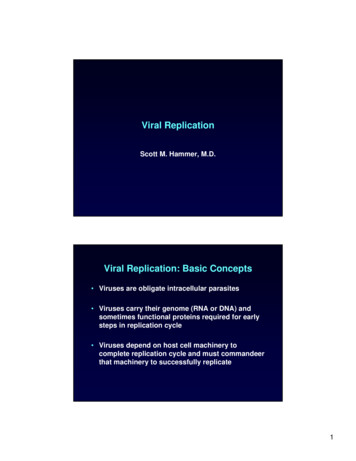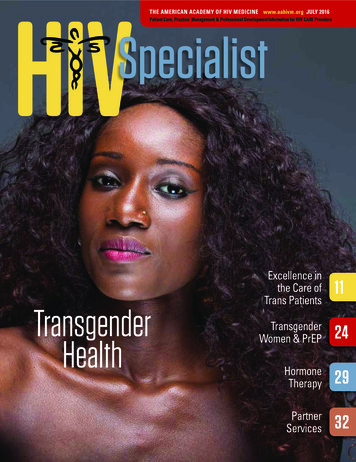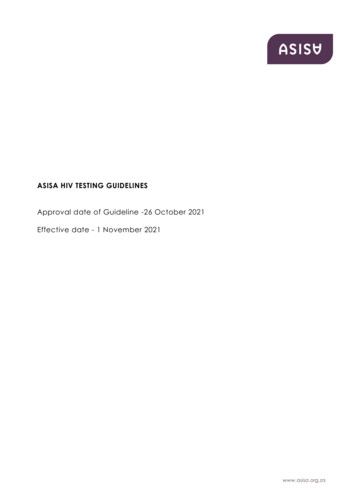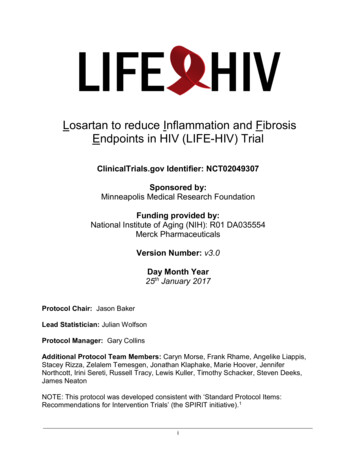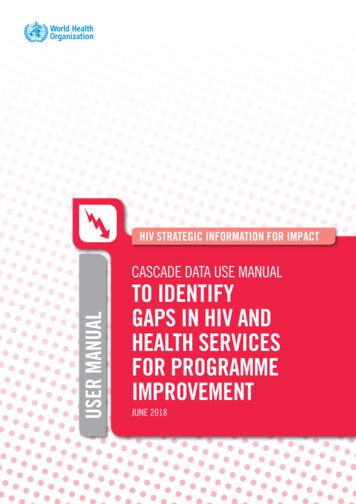
Transcription
HIV STRATEGIC INFORMATION FOR IMPACTUSER MANUALCASCADE DATA USE MANUALTO IDENTIFYGAPS IN HIV ANDHEALTH SERVICESFOR PROGRAMMEIMPROVEMENTJUNE 2018
HIV STRATEGIC INFORMATION FOR IMPACTCASCADE DATA USE MANUALTO IDENTIFYGAPS IN HIV ANDHEALTH SERVICESFOR PROGRAMMEIMPROVEMENTJUNE 2018
ivCascade data use manual: to identify gaps in HIV and health services for programme improvementISBN 978-92-4-151441-5 World Health Organization 2018Some rights reserved. This work is available under the Creative Commons Attribution-NonCommercial-ShareAlike 3.0 IGOlicence (CC BY-NC-SA 3.0 IGO; igo).Under the terms of this licence, you may copy, redistribute and adapt the work for noncommercial purposes, provided thework is appropriately cited, as indicated below. In any use of this work, there should be no suggestion that WHO endorsesany specific organization, products or services. The use of the WHO logo is not permitted. If you adapt the work, then youmust license your work under the same or equivalent Creative Commons licence. If you create a translation of this work, youshould add the following disclaimer along with the suggested citation: “This translation was not created by the World HealthOrganization (WHO). WHO is not responsible for the content or accuracy of this translation. The original English edition shallbe the binding and authentic edition”.Any mediation relating to disputes arising under the licence shall be conducted in accordance with the mediation rules of theWorld Intellectual Property Organization.Suggested citation. Cascade data use manual: to identify gaps in HIV and health services for programme improvement.Geneva: World Health Organization; 2018. Licence: CC BY-NC-SA 3.0 IGO.Cataloguing-in-Publication (CIP) data. CIP data are available at http://apps.who.int/iris.Sales, rights and licensing. To purchase WHO publications, see http://apps.who.int/bookorders. To submit requests forcommercial use and queries on rights and licensing, see http://www.who.int/about/licensing.Third-party materials. If you wish to reuse material from this work that is attributed to a third party, such as tables, figuresor images, it is your responsibility to determine whether permission is needed for that reuse and to obtain permission fromthe copyright holder. The risk of claims resulting from infringement of any third-party-owned component in the work restssolely with the user.General disclaimers. The designations employed and the presentation of the material in this publication do not imply theexpression of any opinion whatsoever on the part of WHO concerning the legal status of any country, territory, city or areaor of its authorities, or concerning the delimitation of its frontiers or boundaries. Dotted and dashed lines on maps representapproximate border lines for which there may not yet be full agreement.The mention of specific companies or of certain manufacturers’ products does not imply that they are endorsed orrecommended by WHO in preference to others of a similar nature that are not mentioned. Errors and omissions expected, thenames of proprietary products are distinguished by initial capital letters.All reasonable precautions have been taken by WHO to verify the information contained in this publication. However, thepublished material is being distributed without warranty of any kind, either expressed or implied. The responsibility for theinterpretation and use of the material lies with the reader. In no event shall WHO be liable for damages arising from its use.Printed in Switzerland
vCONTENTSACKNOWLEDGEMENTS .viABBREVIATIONS AND ACRONYMS .viiEXECUTIVE SUMMARY .11. BACKGROUND .22. HIV CARE AND TREATMENT CASCADES .173. DISAGGREGATED HIV CASCADE ANALYSIS .223.1 Cascades for subnational units .223.2 Cascades for key populations .223.3 Example of a key population cascade .264. PREVENTION, CARE AND TREATMENT CASCADE FOR PREVENTION OF MOTHER-TO-CHILD TRANSMISSIONS .274.1 Core indicators and data sources .284.2 Examples of prevention, care and treatment cascades for maternal-child transmission .305. CARE AND TREATMENT CASCADES FOR HIV CO-MORBIDITIES .325.1 HIV-hepatitis B virus co-infection .325.2 HIV-hepatitis C virus co-infection .345.3 HIV-associated tuberculosis .376. INDIVIDUAL-LEVEL LONGITUDINAL CASCADES .436.1 Longitudinal care cascade among persons newly diagnosed with HIV .446.2 Longitudinal care cascade among persons newly diagnosed with HIV .466.3 Longitudinal care cascades among persons newly initiating ART .476.4 Examples of longitudinal cascades .487. WORKING WITH IMPERFECT DATA .497.1 Strengths and limitations of commonly used data sources .497.2 Common biases and limitations in data used for cascade analysis .507.3 Multiple data sources .507.4 Assessing data quality .518. INTERVENTIONS TO IMPROVE DATA QUALITY FOR CASCADE ANALYSIS .529. INTERPRETING AND USING DATA FROM CASCADE ANALYSES .539.1 Analysing cascade data .539.2 Addressing gaps in the cascade .5310. ADDITIONAL BIBLIOGRAPHY .56ANNEX: SUPPLEMENTAL INDICATORS .57REFERENCES .59
viACKNOWLEDGEMENTSThe concepts and material presented in this publication were informed by three workshops organised with several countries and heldin 2015, 2016 and 2017 around HIV cascade analysis. WHO would like to acknowledge the contributions of the participants of thesemeetings, including staff of national AIDS programmes and experts in various fields related to HIV surveillance, patient monitoring andunique identifiers .WHO would like to thank the individuals who contributed to this document, including George Rutherford and Ivana Bozicevic forpreparing this document.WHO would like also to extend special thanks to UNAIDS and United States Centers for Disease Control and Prevention staff, SadnaPatel, John Aberle-Grasse, Annabel Baddely and Avinash Kanchar, WHO staff that contribute in meetings and technical revisions tothis document.Jesus M Garcia-Calleja and Daniel Low Beer (WHO) coordinated the overall process of the development of this tool.Financial acknowledgementFunding to support this work come from the United States President’s Emergency Plan for AIDS Relief (PEPFAR) and the Bill and MelindaGates FoundationIn addition, WHO is thankful to the institutions that contributed staff time and other contributions to the guideline development process.
viiABBREVIATIONSALTAlanine aminotransferaseAPRIAspartate aminotransferase-to-platelet ratio indexARTAntiretroviral therapyARVAntiretroviralsDAADirect-acting antiviralsHBVHepatitis B virusHBeAgHepatitis E antigenHBsAgHepatitis B surface antigenHCVHepatitis C virusHTCHIV testing and counsellingIBBSIntegrated bio-behavioural surveyKPKey populationKPLHIVKey population member living with HIVMSMMen who have sex with menNATNucleic acid testNGONon-governmental organizationPEPFARPresident’s Emergency Plan for AIDS ReliefPLHIVPeople living with HIVPMTCTPrevention of mother-to-child transmissionPrEPPre-exposure prophylaxisPWPregnant womenPWIDPeople who inject drugsSTISexually transmitted infectionTBTuberculosisUNAIDSUnited Nations Joint Programme on HIV/AIDSVMMCVoluntary medical male circumcisionWHOWorld Health Organization
1EXECUTIVE SUMMARYPurpose2.This guide supports the use of data to identify and fill gaps in servicesin order to improve HIV and health programmes. Following from theConsolidated Strategic Information Guidelines, high-level indicatorsare organized along a cascade of services which are linked to achieveoutcomes. The guide supports the ways in which these cascade dataare analysed and used to identify gaps and better link services.Understanding how cascades can be used toassess whether interventions have been effective andare well linked to each other along a results chain inorder to achieve outcomes.3.Understanding how biases in the data used toconstruct the cascades can affect interpretation of thefindings.4.A step-by-step approach to developing andinterpreting findings from cascades for HIV care andtreatment, HIV prevention and HIV co-infections withHBV, HCV and TB.5.Disaggregating cascades for key and otherpopulations and subnational geographical areas forlocal planning.6.Aligning definitions and use of cascades andindicators so they can be used between nationalprogrammes, partners (e.g. the Global Fund, PEPFAR),and at national, district and facility levels.Countries, programme managers, health workers and other stakeholdershave indicated the importance of consolidating World HealthOrganization (WHO) guidance for constructing HIV cascades into a singledocument. This manual addresses not only the HIV care and treatmentcascade but also cascades for HIV prevention interventions, such asprevention of mother-to-child transmission, and for co-infections withhepatitis B virus (HBV), hepatitis C virus (HCV) and tuberculosis (TB).The use of cascades is integral to achieving the 90-90-90 global HIVtargets (1) and represents one of the key monitoring strategies forsupporting expansion and linkage of HIV care, treatment and preventionservices (2).This manual provides guidance on:1.Constructing various HIV cascades, and identifyingand interpreting reasons for gaps and linkages alongthe cascade.The cascade data use manual is intended for national andsubnational AIDS control programmes and includes an embeddedMS Excel tool that takes the data entered by users and convertsthem into cascade figures. It aims to support WHO consolidatedguidelines, and how they are used operationally for cascade data,to identify gaps for programme improvement.
21. BACKGROUNDThe widespread scale-up of HIV prevention, care and treatmentworldwide has led to the possibility of ending the AIDS epidemicas a public health threat by 2030 (1). In particular, the Joint UnitedNations Programme on HIV/AIDS (UNAIDS) estimates that this canbe achieved if by 2020 90% of all persons living with HIV (PLHIV)are aware of their HIV status, 90% of all people who know theirstatus are receiving antiretroviral therapy (ART), and 90% of thoseon ART are virally suppressed (2). There are parallel global goals toreduce HIV incidence to less than 500 000 new infections in 2020and to fewer than 200 000 in 2030 (2) and to eliminate motherto-child transmission to 50 new paediatric infections per 100 000live births (3).1Reaching these goals requires using data more actively to identifygaps and strengthen linkages in a cascade of indicators of HIVprevention, care and treatment to improve programmes (Box 1.1).1.1 Cascades – focusing data on gapsand linkages in servicesBox 1.1 What is a cascade?Cascades are frameworks for monitoring gaps in programme services needed to achieve goals and health outcomes. Cascadesconsist of a results chain or a series of sequential events in which each event is linked to achieve a health outcome. Cascadesare usually depicted as vertical bar graphs where the total affected population is in the left-hand column. The ultimate goal isdepicted in the right-hand column. The height of the columns in-between show the number of people reached by the sequence ofactions needed to achieve the goal. Comparing the columns highlights the gaps and linkages at each step (e.g. between testingand treatment or between treatment and viral suppression). The height of the columns can be represented either as a numberor as a proportion of the left-hand column (i.e. the total affected population). The analysis of data in a cascade framework canthen be used to assess the gaps and linkages needed at each stage to achieve an outcome (e.g. between testing, treatment andviral suppression). Indicators are not analysed in isolation, but as part of an overall framework or results chain, to describe andimprove a health programme.Cascades are frameworks for quantifying the magnitude of the gapsin HIV diagnosis, treatment, care and prevention among personswith, or at risk of, HIV infection. The purpose of cascades is: to quantify the magnitude of the gaps along thecontinuum of HIV prevention, diagnosis, care andtreatment; to identify where, along the steps of the continuum,programmes can improve linkage and retention ofpeople in HIV prevention, care and treatment; to identify and analyse causes of the gaps andpriorities to fill them; to link programme services to their goals andoutcomes (e.g. the 90-90-90 targets2 to achievereductions in mortality and incidence); to provide information for planning, prioritizing anddesigning targeted interventions and for improvingthe existing monitoring and evauation system; and to improve the quality of prevention, diagnosis,care and treatment focused on the package ofservices a person requires.Cascades consist of a series of sequential events in which eachevent is contingent on having achieved the preceding event untilthe final outcome is reached (Figure 1.1). HIV cascades havebeen constructed so that the final outcome is one that will have apositive effect on reducing HIV incidence, morbidity and mortality.The definition for elimination of mother-to-child transmission of HIV is 50 new paediatric infections per 100 000 live births and a transmission rates of 5% in breastfeeding populations or 2% in non-breastfeeding populations.2By 2020, 90% of all people living with HIV will know their HIV status. By 2020, 90% of all people with diagnosed HIV infection will receive sustained antiretroviral therapy. By 2020, 90% ofall people receiving antiretroviral therapy will have viral suppression.1
3Figure 1.1 Using the cascade to highlight gaps and linkages in HIV services - Philippines45 00040 00035 00068%30 00025 00020 00015 00032%30%In HIV care13 641On ART12 53310 0005 0000PLHIV42 389Diagnosed with HIV28 826Retained on ART (12m)3 094Viral Load Suppressed2 7611.1.1 Using data to identify programme gaps at nationaland sub national levelsThe events included in cascades are referred to as indicators. Theindicators are defined and prioritized in the WHO ConsolidatedStrategic Information Guidelines. This cascade data use manualsupports how to analyse them and use them to improve programmes.The value of calculating the cascade indicators is that they canoffer an efficient way to visualize and identify programmaticgaps in need of intervention in order to achieve the final goal.Monitoring care cascade indicators over time is a useful wayto judge the impact of new or additional efforts to increaseprogramme impact (Figure 1.2).Figure 1.2 Using the cascade to show how programme gaps are closed over time - 1000084206826937061605000397839800PLHIV linked to carePLHIV retained in carePLHIV viralload test donePLHIV retained on ARTPLHIV retainedvirally suppressed
4HIV cascades have been used most commonly for measuring andmonitoring indicators along the HIV care continuum (4) althoughthey are increasingly applied to HIV co-infections such as chronichepatitis B virus (HBV) infection, hepatitis C virus (HCV) infectionand tuberculosis and to HIV-infected pregnant women, as well asto HIV prevention programmes that go beyond the prevention ofperinatal transmission.HIV cascades can be constructed for the general population or forkey populations (KP). Cascades can use national or subnationaldata and can be disaggregated by sex, age, KP, geographical regionand even at the individual clinic level. A beneficial by-product ofconstructing cascades is that the analytic process may also identifyareas where the quality and availability of data to monitor HIVcare, treatment and prevention can be improved (Figures 1.3, 1.4).Figure 1.3 Using standard cascades to highlight subnational gaps, ThailandCross-sectional cascade for Region-1,North ThailandCross-sectional cascade for Region-6,Thailand100%PLHIVVL suppression0%40%70%On ARTVL suppression62%20%92%In HIV care68%On ART96%Know HIV status86%In HIV care100%PLHIV89%Know HIV status60%80%100%58%0%Cross-sectional cascade for Region-10,North-East ThailandPLHIV0%96%70%40%97%92%71%On ART59%VL suppression60%100%100%In HIV care60%20%80%Know HIV status92%On ART60%PLHIV100%VL suppression40%Cross-sectional cascade for Region-11,South ThailandKnow HIV statusIn HIV care20%80%100%0%20%40%60%80%100%Figure 1.4 County-level cascade analysis to identify and fill programme gaps in the 90-90-90targets, KenyaCounty1st 902nd 903rd 90Linked tocare, past 1year (%)PLHIVidentified(%)Currently incare, past 1year (%)PMTCT: onHAART (%)EnrolledStarted onART (%)In care andon ART (%)PLHIVcurrently onART (%)Currently onART, past 1year (%)Viral loadsuppressionrate (%)PLHIV 51315948022587508646897598765Meru
5In general, cascade indicators represent the targets that we wantto achieve. An ideal cascade is flat: 100% of people with HIV havebeen diagnosed, treated and achieved virological suppression. Forthis reason, indicators that may appear reasonable for inclusionin a cascade may be omitted. For instance, for prevention ofmother‑to‑child transmission (PMTCT), indicators such as theproportion of pregnant women offered HIV testing have beenomitted before the number of pregnant women with HIV infectionbecause there will be a large drop-off in the cascade from thenumber testing negative.1.2 Types of cascadesThis section provides an introduction to the cascades which canbe used to highlight different programme gaps. It shows the basicindicators that are used (usually 3-5) which can be standardized anddisaggregated. The following chapters provide more detail, whichshould be used when there are programme benefits. Limiting thenumber of indicators in cascade analysis is recommended to simplifydata collection so long as it allows greater disaggregation and use ofroutine data for programme improvement.1.2.1 Cascades for HIV care and treatmentCascades for HIV care and treatment were first used in 2005(7,8) and later came into general use (9,10) and have becomeubiquitous in HIV care and treatment monitoring programmes.Excellent early guidance came from WHO’s Western PacificRegional Office and Eastern Mediterranean Regional Office(11,12). These cascades are based on the linked sequence of stepsfor care and treatment to achieve outcomes of reduced mortalityand incidence:3 They typically start with the estimated number of PLHIVin a given country or subnational region. This shouldbe disaggregated by gender (and where possible age),geographical region, HIV-TB, and KP, so that the cascadeindicates which populations should be reached andwhich can link effectively to outreach and prevention; This is followed by the number of people who havebeen diagnosed, including additional analysis ofpositivity yield3 in different areas; Next comes the number of persons who have beenstarted on antiretroviral therapy (ART), with supportinganalysis of adherence rates and retention; The final bar of the cascade shows the number ofpersons who are virologically suppressed (Figure1.1), with additional analysis of the coverage of viralload testing.An additional bar may be added for the number of persons whohave been linked to care.These four steps are sufficient for overall cascade analysis. Tounderstand the gaps at each stage and to improve programmes,the steps require additional analysis– of the stage the epidemicis at, the testing strategies to increase diagnosis, where losses tofollow-up are occurring and for which population group, and thecoverage and representativeness of viral load suppression data.Cascade analysis is about data analysis to improve the programme,and not just about reporting the numbers.A simple cascade framework of a few well defined steps supportsthis data analysis and allows the same framework to be usedat national, district and facility levels and among differentpopulations. The major value of a consistent cascade framework isto promote data use, comparison by time, person and place, andactions to improve the programme.Percentages can also be used on cascades to indicate theproportion of persons who have achieved the goal divided by thetotal number affected and, for instance, to assess progress towardsthe 90-90-90 targets (Figures 1.5 and 1.6).Positivity yield refers to the number of positive tests per persons tested. So, if there is an average of 14 positive tests for every 100 persons tested, the positivity yield is 14%.
6Figure 1.5 Cascade analysis to quantify progress and gaps towards the 90-90-90 targets90%90%205 72490%185 151166 63655%43%27%21%228 582126 604(1) PLHIV population98 325(2) Knowing HIV status(Diagnosed)60 753(3) Linkage to care47 205(4) Currently on ART(5) Viral suppression(VL 40 copies)Figure 1.6 Surveys also provide population-level data for cascades, used by PEPFAR andGlobal Fund to identify gaps for funding, ZIMPHIA, Zimbabwe100DiagnosedOn treatment*Virally suppressed** Error bars represent 95% confidence intervalsPLHIV emaleMaleTotal
71.2.2 Cascades for HIV preventionCascades can also be used to depict HIV prevention efforts,where a sequence of actions is particularly important in achievingoutcomes. There is increasing work on prevention cascades(12‑18), yet these have not yet been standardized and at this stageare not specifically included in this manual. However, in analysingthe health sector cascade, it is important to include prevention andto ensure balanced priority-setting of actions to fill gaps in bothprevention and treatment. Three areas are included in this manual: The cascade for care and treatment offersopportunities for linking to preventioninterventions. Links to prevention should be assessedat each stage, particularly when testing (i.e. for personstesting negative or positive) and when providing communityadherence to people on treatment and their partners; In general, the start of the cascade for care andtreatment should disaggregate data on PLHIVand should develop differentiated strategies thatreach key and at-risk populations, combining outreachprevention and treatment. This link is critical forprevention and for generating the flow of diagnoses forthe treatment cascade; Cascades to monitor PMTCT of HIV are a specialsubset of prevention cascades. PMTCT cascadesincorporate both treatment (of mothers) and prevention(in infants) with the goals of both prevention of HIVtransmission to the baby and enrolment of infectedmothers and babies into care and treatment. However,as a prevention cascade, its primary endpoint is thenumber of uninfected infants (Figure 1.7). PMTCTcascades are described in detail in Chapter 4.Figure 1.7 PMTCT cascade used on a quarterly basis to identify and fill gaps in theprogramme, ZimbabweANC PMTCT Cascade Jan-Sept 2016450 000400 000433 194Pregnant women350 00024 990 7.7%300 000294 205 98%ANC women booking already HIV 250 000Booked already HIV Positive (KNOWN STATUS)200 000Booked already on ART150 000PW eligiblefor testing100 000299 388 92%70 62450 0000ExpectedpregnanciesPW bookingfor 1st ANCPW testedfor HIVNeed forPMTCTIdentified 42 536 60%, PMTCT coverage is at 59% 41 752The primary aim of prevention is to prevent people from becominginfected. In contrast to the HIV care and treatment cascade thatstarts with the number of PLHIV, prevention cascades generallystart with the number of uninfected people at risk for HIVinfection; people can then be followed across various preventionprogrammes with an endpoint of not becoming infected.24 990 47%17 546 33%PW HIV positivein ANC23 064 44%18 688 35%PW on ART(B ) in ANC
81.2.2.1 Combination of prevention and care: linking prevention tocare at each stage of the health sector cascadeEvery step of the care and treatment cascade offers anopportunity to provide prevention interventions. Forinstance, the sexual and needle-sharing partners of PLHIV are atan especially high risk of infection and they would be part of thegroup at risk for HIV infection. Risk is greatest in the early stage ofin infection, during the earliest period of ART before viral load fallsand during periods of ART failure when viral load rises again (19).In particular: Strategies for diagnosis should provide both preventionand linkage to care services. Testing positive provides opportunities for preventionfor index cases and their partners. Programmes for retention on treatment andmaintainenance of viral suppression (including gaps inviral suppression) also provide opportunities for deliveryof prevention to individuals and communities. The importance of prevention should be emphasized ateach clinical encounter with PLHIV who need access toprevention commodities, and their partners should bereferred for outreach prevention interventions.1.2.2.2 The first 90 4 – an opportunity for linkage to care andto preventionThe first step of the care and treatment cascade – HIVtesting services – offers opportunities: for persons diagnosed with HIV to enter into care andachieve viral suppression;for persons who test negative but are at risk to bereferred to prevention services.In this cascade, testing has three stages (to which additional stepscan be added if they have programmatic value):41.Risk yield – number and proportion of uninfectedpeople at elevated risk of infection that are identifiedand differentiated by age, sex and KP;2.Referral to relevant prevention services –number and proportion of those at risk referred torelevant prevention services. This should be based ondifferentiation of, for instance, pre-exposure prophylaxis(PrEP), voluntary medical male circumcision (VMMC)and KP programmes;3.Retesting (and retention) – number and proportionof people retained in the prevention intervention andretested for HIV after a defined period (e.g. after 3, 6or 12 months). This provides the outcome in terms ofkeeping at-risk persons free from infection, and alsogives insight into HIV incidence rates.By 2020, 90% of all people living with HIV will know their HIV status.HIV testing can be focused on the positivity yield – theproportion of people diagnosed per total tested. Similarly,prevention can be focused on the proportion of uninfected peopleat elevated risk of infection who are identified. This risk yieldis analogous to positivity yield and can help focus on anddifferentiate between prevention programmes on individuals andpopulation groups at the highest risk of incident infection.Assessing level of risk can be approached by a series of screeningquestions (Box 1.2). If the answer to any of the questions is yes,the person should be considered at high risk of HIV infection.This can be presented as a stacked bar graph, where those who arefound to be infected move into care and treatment, those at highrisk of infection or who are members of key or priority populationsreceive intensive prevention follow-up, those at some risk receivemore modest interventions and those with little or no risk receivecounselling and condoms (Figure 1.8).Training is required so that persons in testing services can e
The cascade data use manual is intended for national and subnational AIDS control programmes and includes an embedded MS Excel tool that takes the data entered by users and converts them into cascade figures. It aims to support WHO consolidated guidelines, and how they are used operationally for cascade data,








